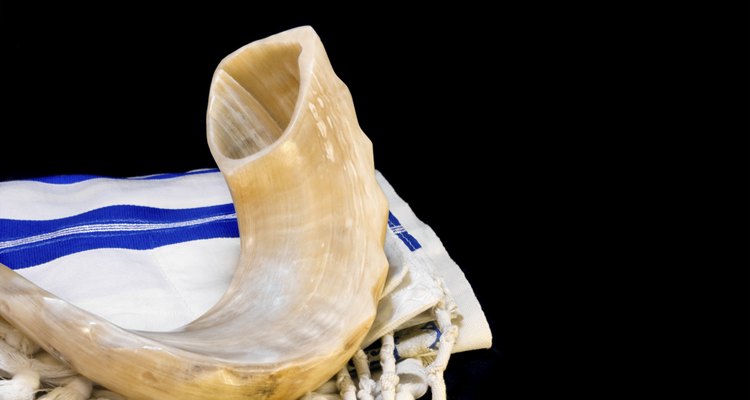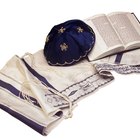
leah613/iStock/Getty Images
In the 12th century, Rabbi Moses ben Maimon, also known as Maimonides, wrote his classic "Sefer HaMitzvot" –- "The Book of the Commandments" -- a systematic enumeration of the 613 commandments derived from the Torah. The tassels, or tzitzit, that dangle from the four corners of a Jewish prayer shawl remind a Jew of his obligation to observe these commandments.
Biblical Origin
The command, or mitzvah, to attach tassels to four-cornered garments appears in Numbers 15:38. The verse reads, "Speak to the children of Israel and tell them to make tassels on the corners of their garments, throughout their generations." Ancient Jews wore large cloaks with four distinct corners, and the Torah required them to attach tzitzit to the corners. Jews of today wear specially manufactured four-corned garments -- tallit katan and tallit gadol -- to which the tassels are attached. Observant Jewish males above the age of 3 typically wear a tallit katan -- a relatively small poncho-like garment -- under their shirts. Men wear a tallit gadol -- a large prayer shawl -- over their clothes during the morning prayer service, because the Shema prayer, a central focus of the morning service, specifically mentions the mitzvah of tzitzit.
Visual Reminder
The verse in Numbers 15:39 offers a reason for the mitzvah of tzitzit. Seeing the tassels causes a Jew to remember the 613 mitzvot of the Torah and helps him avoid impulsive and undesirable behavior. Because the verse emphasizes the benefit of "seeing" the tzitzit, some observant Jews have the custom of leaving the tassels untucked, allowing them to hang visibly beneath their shirttails. At all times of the day, whatever a Jew is doing -- studying, working or tossing a football with friends -- his dangling tzitzit are a constant visual reminder of his obligation to God. Ideally, seeing them prompts a Jew to reflect on God's presence, recall his obligations and behave in accordance with the Torah.
Do the Math
The Hebrew word "tzitzit" and the tassels' physical design make them a tangible reminder of the mitzvot. Attaching tzitzit involves pulling four woolen strings through a hole in every corner of the tallit. When the four strings are draped through the hole, they form eight strands. These strands are then wrapped and knotted in a prescribed manner, forming a series of five knots separated by snug coils of string. Every letter in the Hebrew alphabet has its own numerical value. The total value of the letters that compose the word "tzitzit" is 600. If you add the eight strings and five knots of every tassel, the new total is 613, which corresponds to the 613 commandments.
The Blue Thread
Numbers 15:38 indicates that one string of the tzitzit should be dyed blue. The blue color was originally derived from a particular sea creature known as a chilazon. At some point in history, confusion arose around the identification of the chilazon. As a result, it became impossible to produce a blue string in accordance with Jewish law. Although some rabbinic scholars claim the original chilazon has now been re-identified, others remain skeptical. While some observant Jews now wear tzitzit with a blue string, most wear only white.
Related Articles

How to Make a Jewish Prayer Shawl

Contemporary Tenebrae Service Ideas

Prayer Shawls at Jewish Weddings

How to Wear a Prayer Shawl

How to Name a Baby According to Islam

Dress Etiquette for Jewish Funerals

Do Guys Really Shut off Their Feelings ...

What Do Chinese Women Wear?

Brechtian Exercises

How to Wear Foreign Jump Wings on the ...

What Is the Meaning of Colored Bandanas?

How Long Do You Wear the Ribbon for a ...

Levis Jeans Label History

What Is an African Kufi Hat?

The Difference Between a Corsage & ...

How to Sew Marine Corps Stripes on ...

Military Dress Blues Setup Guide

Types of Masonic Rings

Ribbon Meanings for a Handfasting ...

Clothing of the Children During the ...
References
Writer Bio
Judy Fisk has been writing professionally since 2011, specializing in fitness, recreation, culture and the arts. A certified fitness instructor with decades of dance training, she has taught older adults, teens and kids. She has written educational and fundraising material for several non-profit organizations and her work has appeared in numerous major online publications. Fisk holds a Bachelor of Arts in public and international affairs from Princeton University.
Photo Credits
leah613/iStock/Getty Images